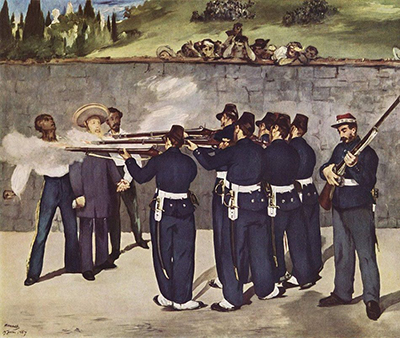The Execution of Emperor Maximillan is a series of three large paintings depicting the killing of Archduke Ferdinand Maximilian in 1879.
Edouard Manet, the painter, also produced a smaller sketch and lithium on the same subject. The emotional drawing shows a firing squad pointing riffles at the emperor and shooting him at close range. Maximillan tilts his head back as a bullet from a smoke emitting gun hits him. Close to the firing squad is an officer loading his gun; villagers are also shown watching the proceedings from a safe distance. The subject of the series was indicative of the volatile political situation in Mexico at the time.
Eduardo Manet was a French painter who lived between 1832 and 1883. He was a well known artist in the 19th century and a key figure in the switch from realism art to impressionism art. His unique and innovative style heavily influenced future painters. Many critics responded negatively to subjects of his paintings which were deemed controversial. Edouard Manet‘s paintings are still relevant in the modern society. The final piece of the Execution of Emperor Maximillan is stationed at the Kunsthalle Mannhein and a piece created earlier displayed at the National Gallery, London.
A third incomplete painting, which was donated by its owners in1930, is currently being held at the Museum of Fine Arts in Boston. Manet created his major piece, The Luncheon on the Grass, earlier in his art career. The sketch-like piece was also quite controversial as it featured a nude woman alongside fully clothed men. The painter also used a rough sketch-like technique, a new style at the time. The composition indicates that Manet borrowed from other painters such as Marcantonio Raimondi.
Another key work, Olympia, was as shocking as it was unique. When it was first displayed at ‘Salon of Paris’, in 1965, it elicited disdain and ridicule. Not only did Manet deviate from the religious theme paintings that were common at the time, he also used very rough strokes to create it. The artist used Victorine Meurent as a model to depict a woman who sold her body. The raw painting shows a free-spirited woman who is not shy to show off a body that isn’t perfect. While it was common for rich men in Paris to visit Courtesans, they felt very uncomfortable seeing the painting hung in a gallery. Guards were stationed near it to protect it from people who were not ready to face it.




